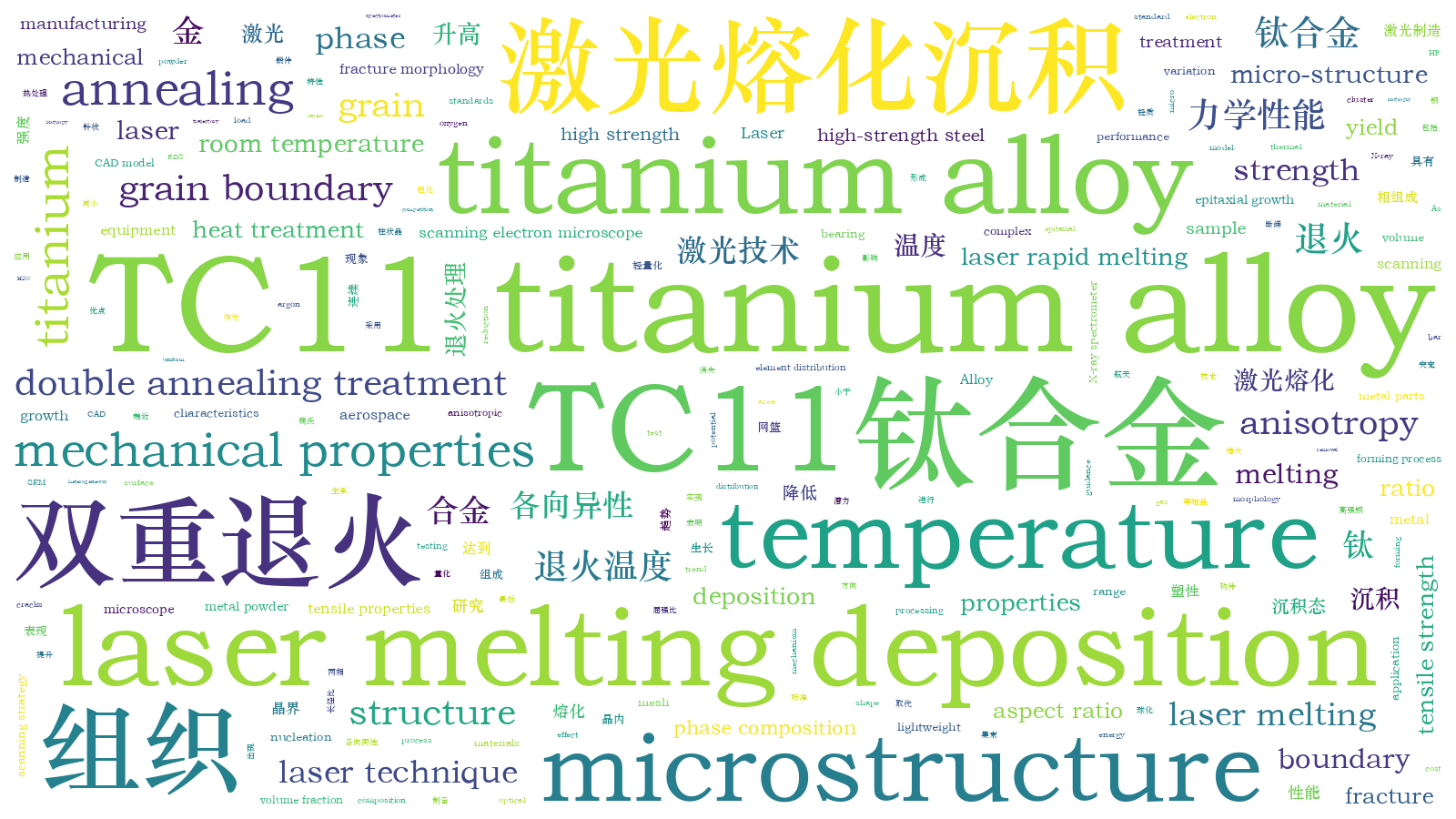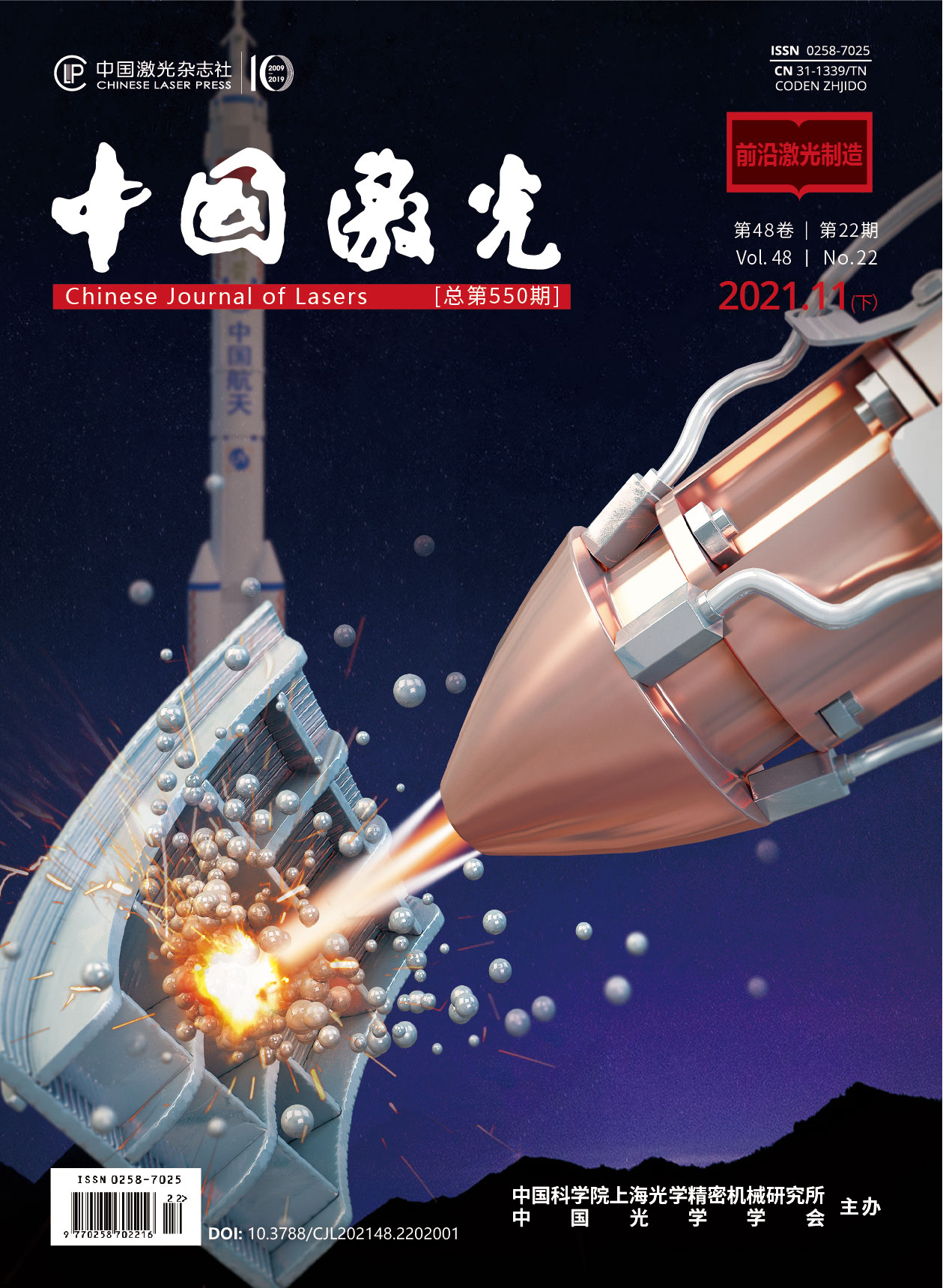激光熔化沉积TC11钛合金双重退火后的组织和力学性能研究  下载: 827次封面文章
下载: 827次封面文章
Objective TC11 titanium alloy is lightweight and has high strength, and it has a great potential to replace high-strength steel as the main bearing components of aerospace, allowing for lightweight application. Traditional manufacturing of large titanium alloy structural parts generally requires large forging equipment and moulds, resulting in considerable manufacturing challenges, such as low material utilisation, long manufacturing cycles and high equipment and production costs. Laser melting deposition uses metal powder or wire as raw materials to form layer by layer via laser rapid melting, and it can directly realize the near-net shape of complex metal parts from the CAD model. Because this technology does not involve thermal-mechanical processing, the amount of removal is small, and it can avoid the dependence on moulds and large forging equipment, it can significantly reduce the manufacturing cost and cycle of large metal components in the aerospace field. The microstructure of titanium alloy deposited using laser melting is complex and the mechanical properties are anisotropic. To meet the application requirements of aerospace main load-bearing components, the heat treatment of TC11 titanium alloy components formed using laser melting deposition must be studied to homogenise the structure and anisotropy and improve the overall performance of laser melting deposited parts.
Methods The as-deposited TC11 titanium alloy was subjected to double annealing heat treatment in this study to investigate the effects of different annealing temperatures on the microstructure and mechanical properties of the TC11 titanium alloy. In this study, a Z-shaped scanning strategy was used to perform laser melting deposition of TC11 titanium alloy bulk. The scanning trajectory between the layers was deflected by 90°, and argon gas was introduced during the forming process to reduce the amount of water and oxygen volume fraction in the glove box less than 5×10 -5. The deposited sample and the heat-treated test bar were processed into standard tensile samples, and their tensile properties at room temperature were tested on a universal tensile testing machine. Kroll’s reagent was used to corrode a TC11 titanium alloy sample (the volume ratio of HF, HNO3, and H2O is 1∶2∶7). The structure, element distribution, phase composition, and fracture morphology of the deposited and heat-treated titanium alloy were detected and analysed using an optical microscope (OM), scanning electron microscope (SEM), and energy dispersive X-ray spectrometer (EDS), and the relationship between heat treatment-structure-performance was established, providing guidance for improving the comprehensive properties of TC11 titanium alloy components deposited by laser melting.
Results and Discussions Along the deposition direction, the structure of TC11 titanium alloy exhibited alternate growth of columnar grain zone and equiaxed grain zone (Fig.2). The deposited state’s micro-structure was composed of the Widmanstatten and mesh basket structures, and a portion of the clustered phase in the equiaxed zone grew through the entire grain. The phase of the intragranular basket structure gradually coarsened as the annealing temperature increased and the aspect ratio gradually decreased. When the annealing temperature rose to 1025 ℃, the intragranular structure abruptly changed into a fine needle-like basket structure and the aspect ratio increased. With the increase of the temperature, the grain boundary α phase gradually appeared discontinuous, spheroidised and disappeared. When the annealing temperature was 1025 ℃, the continuous grain boundary α phase was reformed in the equiaxed grain boundary (Fig.4). With the increase of annealing temperature, the overall tensile strength (Rm) showed a slight decrease; when the annealing temperature was 1025 ℃, Rm increased, and the range of variation in tensile strength was ≤3.76%. With the increase of the high-temperature annealing temperature, the yield strength (Rp0.2) did not change much, and the range of variation in yield strength was ≤1.16%. The percentages of elongation after fracture (A) of transverse sample showed a slight change as the high-temperature annealing temperature increased, and the longitudinal sample increased first and then decreased. In general, the reduction of area (Z) showed an overall trend that increased first and then decreased. The yield ratio increased as the high-temperature annealing temperature increased, reaching its maximum at 1010 ℃. The laser melting deposition of TC11 titanium alloy had a strength that was nearly isotropic, and heat treatment had little effect on the anisotropy of tensile and yield strength.
Conclusions The deposited structure of TC11 titanium alloy exhibits columnar/equiaxial alternate growth along the deposition direction owing to competition between heterogeneous nucleation and epitaxial growth nucleation. The deposited microstructure is mainly composed of the Widmanstatten structure composed of grain boundary cluster α phase and the intracrystalline fine needle-like basket structure. As the annealing temperature increases, the aspect ratio of the intragranular α phase decreases, and the grain boundary α phase appears discontinuous, spheroidised, and partial disappeared. When the annealing temperature is 1025 ℃, the grain boundary reforms a continuous grain boundary α phase, and the intragranular structure abruptly changes to a refined mesh basket structure. Both the mechanical properties of deposited and heat-treated TC11 titanium alloy can meet forging standards, and double annealing can significantly improve the deposited mechanical properties. Owing to the intragranular and grain boundary structure, as the annealing temperature rises, the strength of the TC11 titanium alloy first decreases and then increases, whereas the plasticity increases first and then decreases. With the increase of annealing temperature, the yield ratio first increases and then decreases, reaching the maximum at 1010 ℃. The strength anisotropy of TC11 titanium alloy in the as-deposited and dual-phase zones is less than 3%, which is close to isotropy; the plasticity anisotropy first increases, then decreases, and is smallest at 995 ℃. The transverse and longitudinal tensile fractures of the deposited state exhibit intergranular fracture characteristics as a result of the intragranular structure and continuous grain boundaries; after double annealing, the grain boundaries appear discontinuous, spheroidised, and disappeared, and the cracks continue to grow by the mechanism of micropore aggregation, and the fracture surface shows the characteristics of ductile fracture, and the dimple fractures are the most uniform at 995 ℃.
郝云波, 赵凯, 黄叶玲, 齐超琪, 杜洋. 激光熔化沉积TC11钛合金双重退火后的组织和力学性能研究[J]. 中国激光, 2021, 48(22): 2202001. Yunbo Hao, Kai Zhao, Yeling Huang, Chaoqi Qi, Yang Du. Microstructures and Mechanical Properties of Doubled Annealed Laser Melting Deposited TC11 Titanium Alloy[J]. Chinese Journal of Lasers, 2021, 48(22): 2202001.







